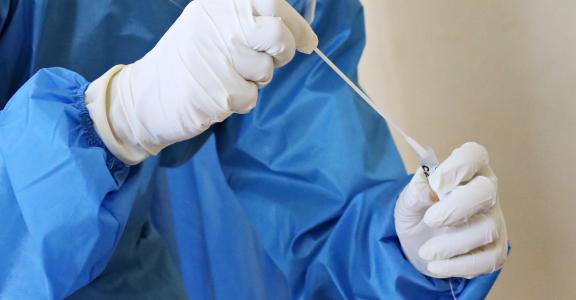Until recently, the world record for developing a vaccine was the mumps vaccine, which was developed in four years. We now know that it can be done much faster. In mid-January 2020, BioNtech launched the 'Lightspeed' project. This project resulted in the first corona vaccine receiving approval in early December 2020. How did this happen and what can companies in the industry learn from it?
Lesson 1: Separate technology and product development
A first key milestone in the development of the vaccine was the decipherment and publication of the genetic code of the virus in January 2020. This gave the virus a 'digital twin', as it were. This digital version of the virus allowed scientists to study the virus without having the virus itself in their laboratory.
Digitalisation in the development process is crucial, but this is not the lesson for manufacturing companies. After all, the use of digital models and tools to develop products has been well established in the manufacturing industry for many years. Another revolution had quietly taken place in the background. The many years of preliminary research had finally brought us to the point where, based on existing technologies, a vaccine tailored to the virus could be configured. The individual technologies (such as the fat globules in which the mRNA is safely stored) had already proven themselves in other therapies in the past. It was the accumulation of technologies that made it possible to develop the first vaccine candidates on the basis of the genetic code after only a few weeks.
Herein lies an important lesson for companies. To successfully develop new products, companies must have a reliable and fast development process. This contrasts with the slow and risky development process of a new technology. This contradiction can only be bridged by separating the development of the actual products from the development of the underlying technologies. Separating product and technology development is a key principle for reducing development lead times. If this is not done, new product developments risk taking a very long time and getting bogged down in all kinds of unforeseen problems.
Separating product development from technology development implies drawing up a technology roadmap that identifies the relevant technologies for the future. The next step is to find out how to acquire or develop these technologies. Often, the necessary technologies can be purchased from third parties. For example, Pfizer/BioNTech acquired a licence for the LNP technology for the fat globules from Acuitas Therapeutics.
Lesson 2: Accelerate testing
On 23 April 2020, the first test subject was vaccinated with the Pfizer/BioNtech vaccine. Barely seven months later, the hopeful conclusion of the final Phase 3 study was known. Pfizer needed only 16 weeks to recruit 43,000 volunteers for the tests. By comparison, in 2013 it took 813 days to find 101 volunteers to test the rabies mRNA vaccine.
Like in vaccine development, the testing phase of new products in industry often takes up a considerable amount of time. Before testing can take place, prototypes often need to be built and test facilities need to be available. Different strategies are possible to speed up the testing.
Firstly, capacity can be reserved in advance in the prototyping and testing departments, so that the new products do not have to queue up.
Secondly, one should consider the organisational separation of prototype production from regular production. As a result, the prototyping department has its own machine park at its disposal and regular production is no longer disrupted by prototyping orders. As long as prototypes are made using the means of regular production, future products must compete with current orders. This struggle is often settled to the detriment of the new products under short-term pressure.
Thirdly, one should also consider simply providing additional capacity to avoid bottlenecks. The fallacy par excellence is to believe that a resource utilisation level of 100% is optimal. Striving for a high utilisation level inevitably leads to long waiting times and a lot of missed revenues owing to delayed product launches. Estimating the loss due to a one-day delay in time-to-market provides a good basis for making the right decisions. For example, the cost of the corona crisis in Belgium alone was approximately EUR 60 million per day. This indicates that tens of millions more can be spent to reduce the time to market of a vaccine by one day.
Lesson 3: Work in small batches
On 21 December 2020, the European Medicines Agency (EMA) approved Pfizer/BioNtech's vaccine in a record time of 19 days after the formal application. The approval of a new medicine typically takes a year. The medicines' authority spends about 210 days on analysing an application. The remaining months are taken up with back and forth communication between the medicines' agency and the pharmaceutical company. The acceleration of the decision-making process was also made possible by the use of 'rolling reviews', whereby interim test results were already analysed by the EMA before the full test results were available.
The rolling reviews are a good example of the principle of batch reduction. By splitting the work into smaller batches and sending it on to the next step, the turnaround time can be reduced by letting the work overlap the different steps. This principle can be applied generally, both in product development and in production. For example, developers often wait until the entire drawing package is ready before they pass it on to the next department. In order to shorten the turnaround time, it is better to forward a completed partial package of drawings to the next department as soon as possible.
Lesson 4: Eliminate waiting for information
(Source picture: https://www.dreamstime.com)
In addition to the rolling reviews, the approval time was also reduced by accelerating the back-and-forth communication between the parties involved. Herein lies another lesson for companies: avoid unnecessary waiting times as colleagues wait for information from each other. Shortening this waiting time is quite easy.
One approach is to physically assemble the relevant colleagues. This avoids emails going back and forth and questions are answered immediately. If this is not possible, warm transfers can be organised. In a warm transfer, colleagues sit together in order to discuss the transfer of complex information. This allows for an immediate interview where all ambiguities can be cleared up immediately. At the same time, colleagues learn from each other what information the other needs. In contrast to the warm transfer, there is the cold transfer, wherein the information is sent to each other by e-mail, or entered into a system somewhere. As a result, the receiving colleague must first find out for himself what is going on, and then a time-consuming e-mail chain of questions and confusing answers begins.
Lesson 5: Ensure clear focus
(Source picture: https://www.dreamstime.com)
Nobody was waiting for the corona crisis. Neither did the vaccine developers, who were busy developing other medicines. Owing to the intensity of the corona crisis, all other projects were put aside and priority was systematically given to corona. This clear focus is a key explanation for the rapid development and market launch of the vaccines.
Setting clear priorities is a key principle for reducing development lead times. Many developers are working on several projects at the same time. Because of this, a lot of energy and time is lost by constantly switching between projects. At the same time, management loses time in resolving resource conflicts between projects and employee ownership is undermined. Therefore, limit the number of projects one works on to the strict minimum. If you are working on more than one project, make sure you prioritise so that everyone works on the most valuable project.
Sources
]]>



